Are you tired of a cluttered closet? An organized closet can make a significant difference in your daily routine, saving you time and reducing stress. With a few simple DIY hacks, you can transform your closet into a serene and functional space.
Having a well-organized closet is not just about aesthetics; it’s also about creating a system that works for you. By implementing closet organization ideas, you can maximize your storage, reduce clutter, and make the most of your space.
Key Takeaways
- Simple DIY hacks can transform your closet.
- An organized closet saves time and reduces stress.
- Maximizing storage is key to a clutter-free closet.
- Customized organization systems work best.
- A well-organized closet enhances your daily routine.
Assessing Your Closet Space
A thorough assessment of your closet space is crucial for determining the best organization strategies. This initial step helps you understand what you’re working with and identify areas for improvement.
Taking Inventory of Your Belongings
Start by taking everything out of your closet. Sort items into categories, such as tops, bottoms, dresses, and outerwear. This process helps you see what you have, making it easier to decide what to keep, donate, or discard. Be sure to check for expired or damaged items that are no longer usable.
Identifying Problem Areas and Pain Points
As you inventory your belongings, identify the challenges you’re facing. Are your clothes overcrowded? Do you struggle to find what you need? Are there any damaged or inefficient storage solutions? Recognizing these issues will help you find targeted solutions.
Measuring and Mapping Your Available Space
Measure your closet’s dimensions, including the length, width, and height. Note any obstacles, such as heating vents or electrical outlets. Create a simple sketch or map of your closet, highlighting the available space and potential storage areas. This visual representation will help you plan your organization system more effectively.
| Measurement | Dimension | Notes |
|---|---|---|
| Length | 60 inches | Available for double rod installation |
| Width | 30 inches | Ideal for shelving units |
| Height | 90 inches | Allows for upper shelf storage |
By following these steps, you’ll be well on your way to creating a more organized, functional closet that makes the most of your available space.
The Decluttering Process: First Step to Organization
The journey to an organized closet begins with a thorough decluttering process. This step is crucial as it allows you to assess what you have, what you need, and what you can discard, making the organization process much simpler.
The Four-Pile Method: Keep, Donate, Sell, Trash
One effective way to declutter is by using the four-pile method. This involves categorizing your belongings into four piles: items to keep, items to donate, items to sell, and items to throw away. This method helps in making decisions about each item in your closet.

Decision-Making Questions for Efficient Decluttering
To declutter efficiently, ask yourself questions like: “When was the last time I used this item?”, “Does it fit me well?”, and “Is it in good condition?” These questions help in making tough decisions about what to keep and what to discard.
Creating a Seasonal Decluttering Schedule
To maintain your closet’s organization, consider creating a seasonal decluttering schedule. This involves setting aside time each season to go through your closet and remove items that are no longer needed or that are out of season. This practice helps in keeping your closet clutter-free throughout the year.
By following these decluttering tips and maintaining a regular decluttering schedule, you’ll be well on your way to a more organized closet.
Planning Your Closet Organization System
Effective closet organization starts with a well-thought-out plan. To create a system that works for you, it’s essential to consider your lifestyle, usage patterns, and available space.
Determining Your Storage Needs by Lifestyle
Understanding your storage needs begins with assessing your lifestyle. Ask yourself: What type of clothing do I wear most often? Do I have a lot of shoes or accessories that need storage? Consider your daily routine and the items you use regularly. This will help you determine the types of storage solutions you need, such as double rods for maximizing hanging space or shelves for folded items.
Creating Functional Zones Based on Usage Frequency
Creating functional zones in your closet can significantly enhance its usability. Divide your closet into areas based on how frequently you use the items stored there. For example, you can have a zone for daily wear, another for seasonal clothing, and a separate area for out-of-season items. This approach ensures that the items you need are always accessible.
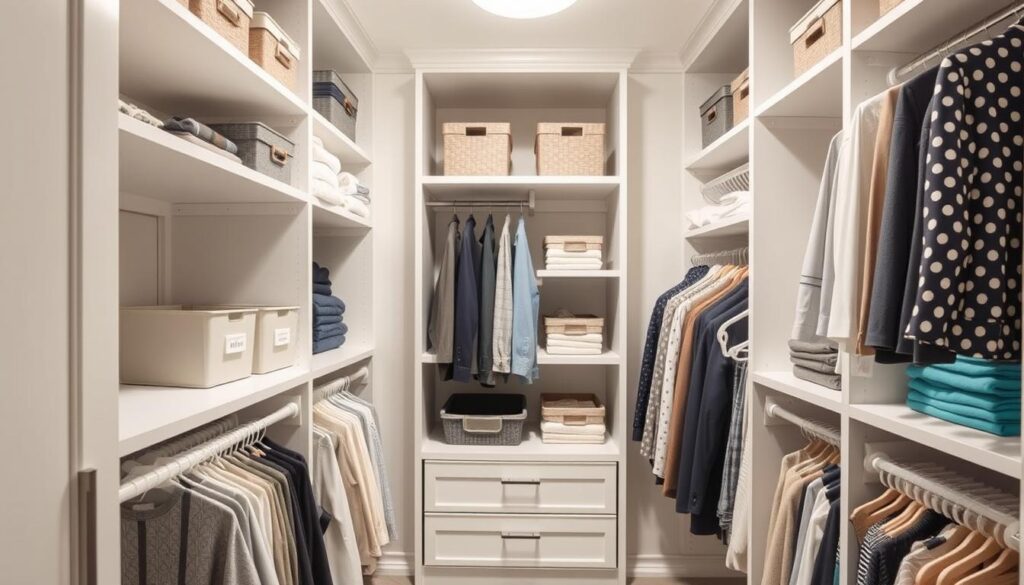
Sketching Your Ideal Layout Before Implementation
Before you start implementing your closet organization system, sketch out your ideal layout. Consider the space available, the storage solutions you’ve decided on, and how you can best utilize the area. Use graph paper or a digital tool to create a rough sketch. This visual representation will guide you during the implementation phase, ensuring that your closet is both functional and aesthetically pleasing.
By following these steps, you can create a closet organization system that is tailored to your needs, making your daily routine more efficient.
Essential DIY Tools and Materials for Closet Organization
A well-organized closet starts with the right DIY tools and materials. To achieve your dream closet, you’ll need to gather a few essential items.
Basic Tools Every DIY Organizer Needs
Every DIY organizer should have a basic toolkit that includes a drill, a level, a tape measure, and a stud finder. These tools will help you hang shelves, install rods, and ensure everything is perfectly aligned.
Budget-Friendly Materials That Last
You don’t have to break the bank to organize your closet. Budget-friendly materials like plywood, MDF, and PVC pipes can be used to create custom storage solutions. Repurposing old crates or baskets can also add a unique touch to your closet.
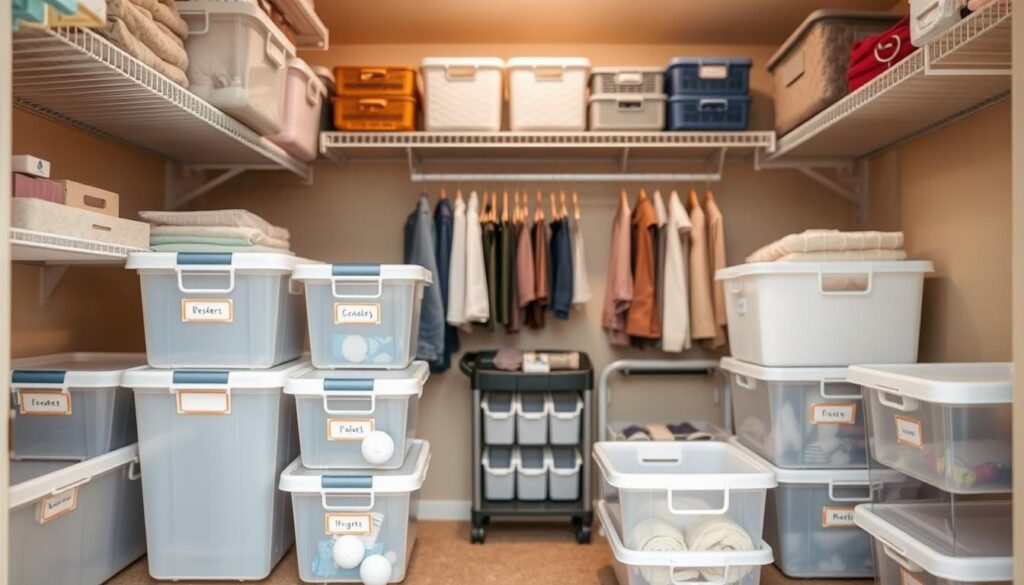
Where to Source Affordable Supplies and Upcycled Items
Thrift stores, garage sales, and online marketplaces are great sources for affordable supplies and upcycled items. You can find everything from gently used shelving units to unique decorative items to enhance your closet’s functionality and aesthetic.
Organize Your Closet with These DIY Hacks
Transforming your closet into a serene and functional space is easier than you think with these innovative DIY hacks. A well-organized closet not only enhances your daily routine but also adds value to your home. Here, we’ll explore some creative and practical solutions to help you achieve your closet organization goals.
Tension Rod Tricks for Instant Organization
Tension rods are versatile and can be used in various areas of your closet. One of the simplest DIY hacks is to use tension rods to create additional hanging space or to section off different types of clothing.
- Double your hanging space by installing a second rod below the existing one.
- Use tension rods to create separate sections for different types of clothing, like dresses or pants.
Repurposed Household Items as Storage Solutions
Before buying new storage solutions, consider repurposing items you already have at home. Old crates, baskets, or even cardboard boxes can be transformed into unique storage containers.
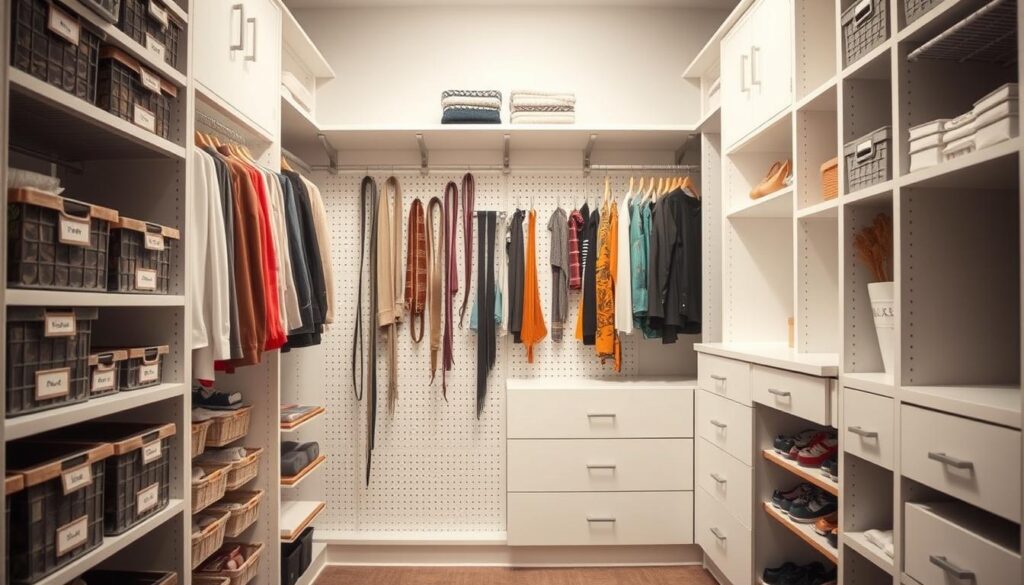
PVC Pipe Projects for Custom Storage
PVC pipes offer a cost-effective and customizable solution for creating storage units within your closet. You can build shelves, hanging rods, or even a shoe rack using PVC pipes.
Unexpected Uses for Shower Curtain Rings and Hooks
Shower curtain rings and hooks are not just limited to the bathroom. They can be repurposed in your closet to hang belts, scarves, or even bags, keeping them organized and easily accessible.
| Item | Original Use | Repurposed Use in Closet |
|---|---|---|
| Shower Curtain Rings | Hanging Shower Curtains | Hanging Belts or Scarves |
| Hooks | Hanging Towels or Robes | Hanging Bags or Accessories |
| Old Crates | Storage or Shipping | Shelving or Storage Containers |
By implementing these DIY hacks, you can create a more organized, functional, and peaceful closet space that reflects your personal style and meets your specific needs.
Maximizing Vertical Space: Walls and Doors
When it comes to closet organization, making the most of your walls and doors can be incredibly beneficial. By leveraging these often-underutilized areas, you can significantly enhance your closet’s storage capacity and overall functionality.
DIY Over-the-Door Organizers for Shoes and Accessories
Over-the-door organizers are a simple and effective way to add extra storage to your closet without taking up valuable floor or shelf space. You can find various over-the-door shoe organizers and accessory holders at home goods stores, or you can create your own using materials like fabric, hooks, or repurposed wooden dowels.
For example, you can hang a shoe organizer with clear pockets to store shoes, bags, or accessories. Alternatively, you can use hooks to hang belts, scarves, or jewelry, keeping them organized and within reach.
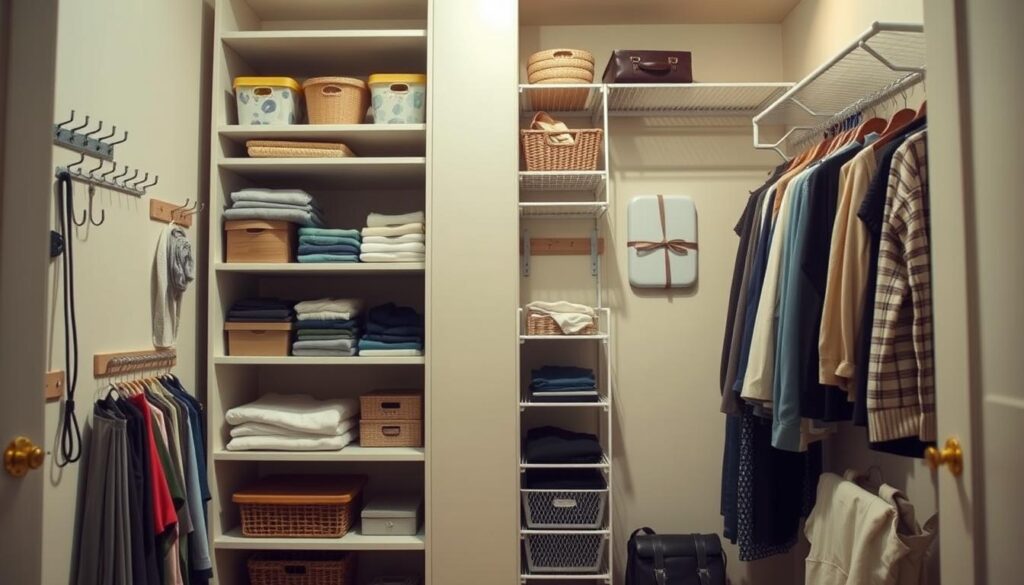
Wall-Mounted Storage Solutions You Can Build
Wall-mounted storage solutions can help maximize your closet’s vertical space while keeping the floor clear. Consider building or installing shelves, hooks, or a pegboard on your closet walls to hang items like jackets, bags, or accessories.
A pegboard is particularly versatile, allowing you to customize the layout with hooks and bins to suit your needs. You can also add a shelf or ledge for folded items or decorative storage bins.
Creative Ways to Utilize the Space Above Hanging Clothes
The space above your hanging clothes is often wasted, but it can be repurposed for additional storage. Consider installing a shelf or storage unit above your hanging rod to store out-of-season clothes, linens, or luggage.
| Storage Solution | Description | Benefits |
|---|---|---|
| Over-the-Door Organizers | Hanging organizers for shoes and accessories | Easy to install, extra storage |
| Wall-Mounted Shelves | Shelves for folded items or decorative bins | Customizable, maximizes vertical space |
| Pegboard | Customizable board with hooks and bins | Versatile, keeps items organized |
By implementing these strategies, you can make the most of your closet’s vertical space, creating a more organized, functional, and peaceful environment.
Small Closet Organization Strategies
Even the smallest of closets can be transformed into an organized oasis with a few simple hacks. Organizing a small closet requires a thoughtful approach to maximize space and reduce clutter.
Space-Saving Hangers and Folding Techniques
One of the simplest ways to optimize closet space is by using space-saving hangers and folding techniques. Velvet hangers, for instance, prevent clothes from slipping off, allowing for more compact storage. Folding techniques like the KonMari fold enable you to store clothing in drawers or on shelves without creating bulk.
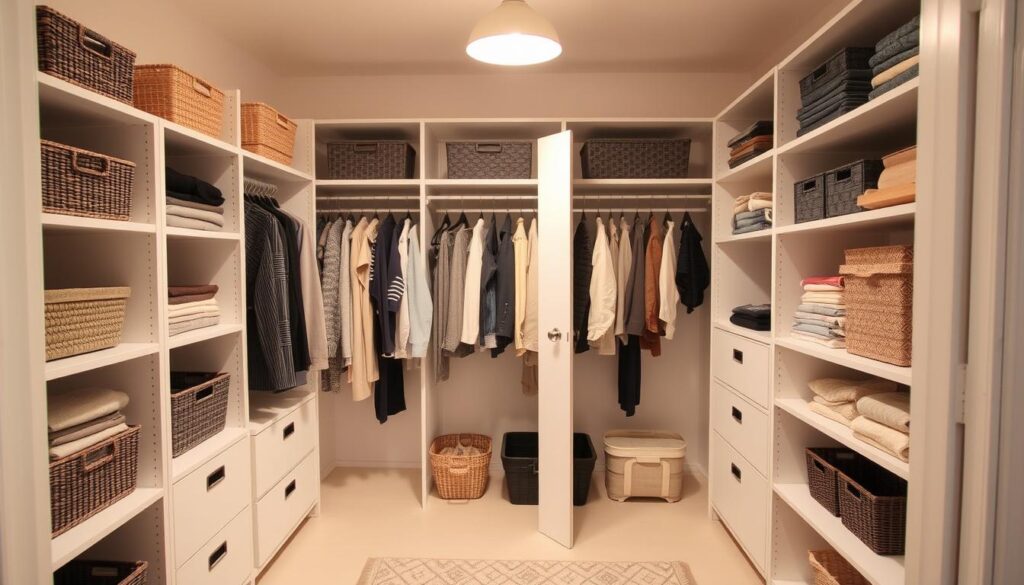
Double-Duty Furniture Ideas for Extended Storage
Incorporating double-duty furniture can significantly enhance storage in small closets. Consider using a storage ottoman or a chest of drawers that can serve multiple purposes, such as seating and storage. These pieces can be especially useful in closets that are used frequently.
Hidden Storage Opportunities in Unexpected Places
Small closets often have hidden storage opportunities that can be leveraged with a bit of creativity. For example, the space above a door or under a shelf can be used for storing less frequently used items. Over-the-door storage racks and under-shelf baskets are excellent tools for maximizing these areas.
Optical Illusions to Make Your Closet Feel Bigger
Creating optical illusions can make a small closet feel more spacious. Using light colors on walls and shelves can create a sense of openness. Additionally, installing a mirror can reflect light and images, making the space feel larger.
By implementing these strategies, you can turn your small closet into a highly functional and organized space. Whether it’s through clever use of hangers, double-duty furniture, or hidden storage, there’s always a way to improve your closet’s organization.
Budget-Friendly Closet Transformation Ideas
Transforming your closet doesn’t have to break the bank. With a little creativity and resourcefulness, you can achieve a stylish and organized space without overspending. Here are some budget-friendly closet organization ideas to get you started.
Dollar Store Finds for Closet Organization
One of the easiest ways to organize your closet on a budget is by shopping at dollar stores. You can find a variety of affordable storage solutions such as bins, baskets, and shelves. These items can help keep your closet tidy and make the most of your space. For instance, using stackable bins to store out-of-season clothes or accessories can be a game-changer.
Top Dollar Store Finds:
- Stackable storage bins
- Adhesive hooks
- Shoe organizers
- Drawer dividers
No-Cost Organization Using What You Already Own
Before buying anything, take stock of what you already have at home. You might be surprised at how many items can be repurposed for closet organization. For example, old mason jars can be used to store small items like buttons or safety pins, while cardboard boxes can be transformed into DIY storage bins.
Repurpose and Reuse:
- Use old crates or boxes for storage
- Hang scarves or belts on existing hooks
- Utilize empty baskets for storing folded clothes
Weekend Projects Under $50 for Complete Closet Makeovers
If you’re willing to invest a bit of time and money, you can undertake simple DIY projects to give your closet a complete makeover. For under $50, you can find materials to build custom shelves, create a double rod, or even install a shoe rack. These projects not only enhance the functionality of your closet but also add a personal touch.
Budget-Friendly DIY Projects:
- Build a custom shelving unit using reclaimed wood
- Create a double rod to double your hanging space
- Install a shoe rack or over-the-door shoe organizer
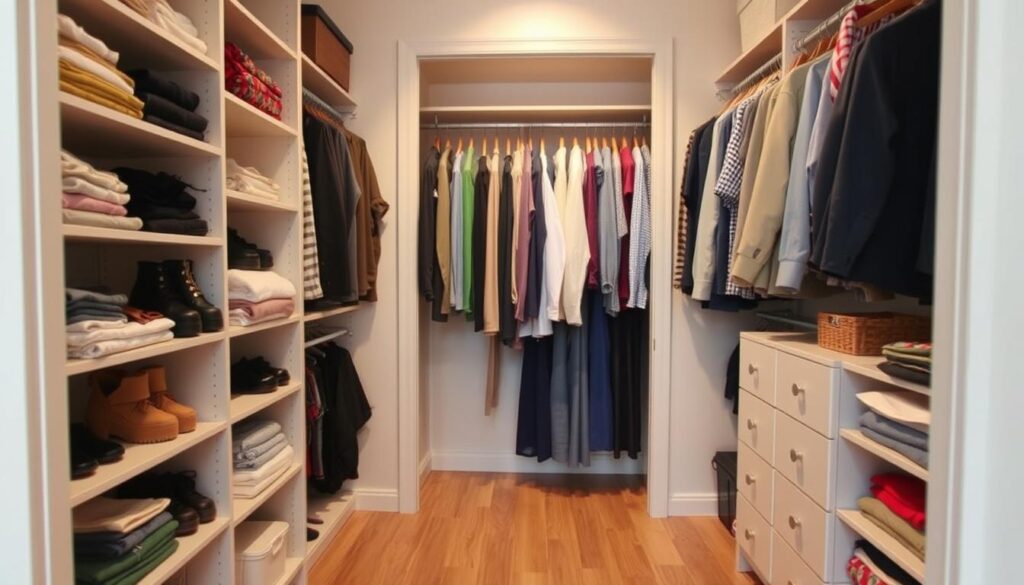
By implementing these budget-friendly closet transformation ideas, you can enjoy a more organized, functional, and stylish closet space without straining your wallet. Whether you shop at dollar stores, repurpose items you already own, or take on a simple DIY project, the key is to be creative and resourceful.
Organizing by Category: Clothes, Shoes, and Accessories
Organizing your closet by category is a practical approach to managing your wardrobe and accessories. This method involves sorting your belongings into distinct groups, making it easier to locate specific items and maintain a clutter-free space.
DIY Clothing Dividers and Custom Separators
Using DIY clothing dividers and custom separators is an effective way to organize your clothes within your closet. You can create dividers using materials like cardboard, fabric, or repurposed items, tailoring them to fit your specific storage needs. For instance, you can use wooden crates or fabric bins to separate different types of clothing, keeping your closet tidy and making your clothes easier to find.
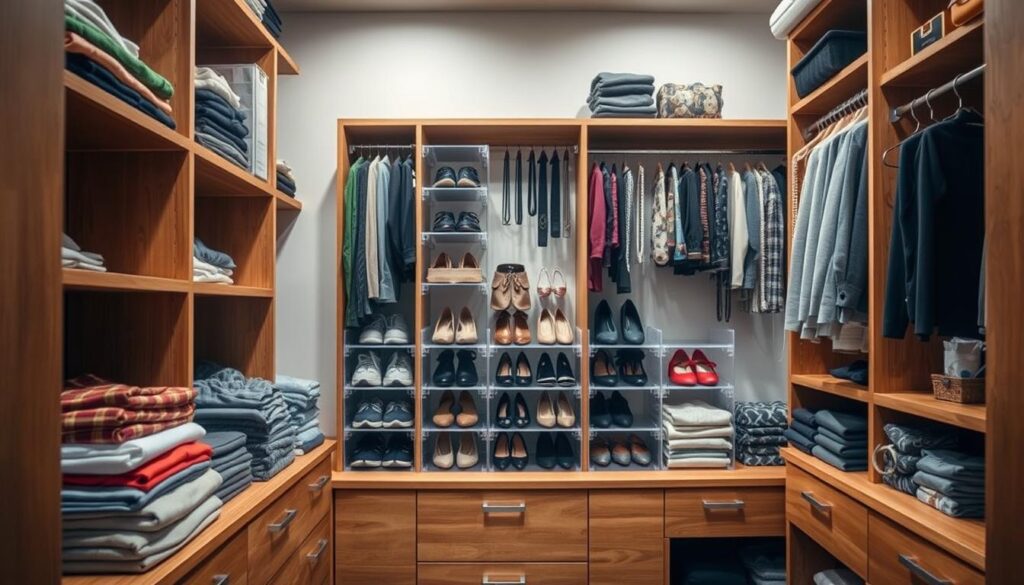
Shoe Storage Solutions for Every Type of Footwear
Shoe storage is a critical aspect of closet organization. There are various solutions available, depending on the type and number of shoes you own. From over-the-door shoe organizers to stackable shoe racks, you can choose the solution that best fits your needs. Consider using clear shoe boxes to store out-of-season shoes, keeping them dust-free and out of the way.
Jewelry and Accessory Organization to Prevent Tangles
Jewelry and accessories can easily become tangled or lost if not stored properly. Utilize jewelry organizers with separate compartments to keep items untangled. You can also repurpose ice cube trays or small containers to store small accessories like earrings, rings, or brooches.
Seasonal Clothing Transition Systems
Implementing a seasonal clothing transition system can help you manage your wardrobe more efficiently. Store out-of-season clothes in labeled bins or containers, and consider using vacuum storage bags to save space. When the season changes, simply swap out the clothes, ensuring that your current wardrobe is easily accessible.
By organizing your closet by category and implementing these practical solutions, you can enjoy a more streamlined and stress-free dressing experience.
Conclusion
Organizing your closet can be a daunting task, but with the right DIY hacks, it becomes a manageable and rewarding project. By assessing your closet space, decluttering, and planning your organization system, you can create a functional and peaceful area that makes your daily routine easier.
With the tips and tricks provided, you can now organize your closet with these DIY hacks and enjoy a clutter-free environment. From utilizing vertical space to implementing budget-friendly solutions, every step counts in achieving your dream closet. Start your closet organization journey today and experience the joy of a well-organized space that reflects your personal style.
For more closet organization ideas and inspiration, explore our comprehensive guides and start transforming your closet into a serene oasis that makes you feel great every time you open the door.



